In pictures: Meetings between Pak, US leaders over the years
From Liaquat Ali Khan in the 1950s to Nawaz Sharif in 2015, the moments that have defined Pak-US relations
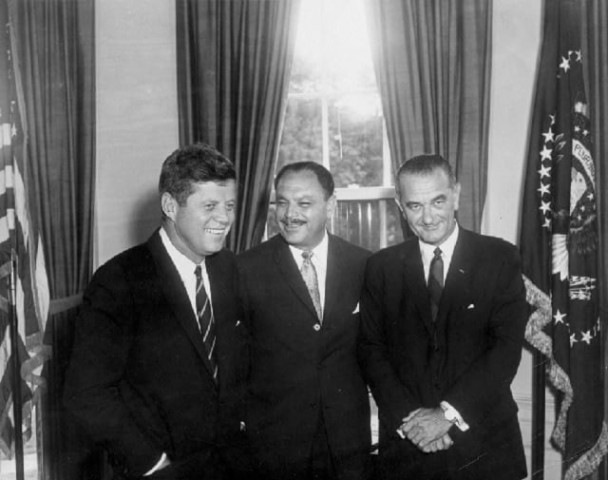
In pictures: Meetings between Pak, US leaders over the years
Prime Minister Liaquat Ali Khan - May 3-5, 1950
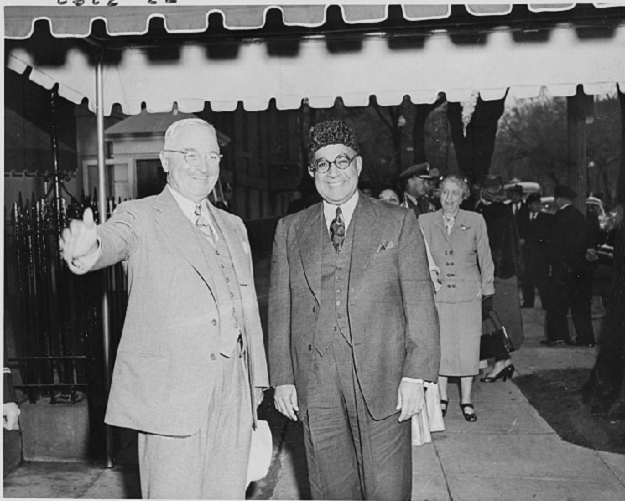 Liaquat Ali Khan and President Harry S. Truman. PHOTO: Wikipedia
Liaquat Ali Khan and President Harry S. Truman. PHOTO: WikipediaLiaquat Ali Khan was accompanied by First Lady Ra'ana Liaquat Ali Khan on what was the first-ever official state visit for Pakistan to the US.
Upon his arrival, Khan was personally received by President Harry S Truman and there was a parade in New York in his honour.
During his trip, he addressed the US House of Representatives and highlighted the importance of Pakistan’s geostrategic location. His visit set the course for Pakistan’s future foreign policy and placed Islamabad in the US sphere of influence.
“This visit not only enabled me to see the American people and their wonderful country but also gave me an occasion to inform the inhabitants of that country about the birth of Pakistan.”
Governor-General Ghulam Muhammad - November 8-13, 1953
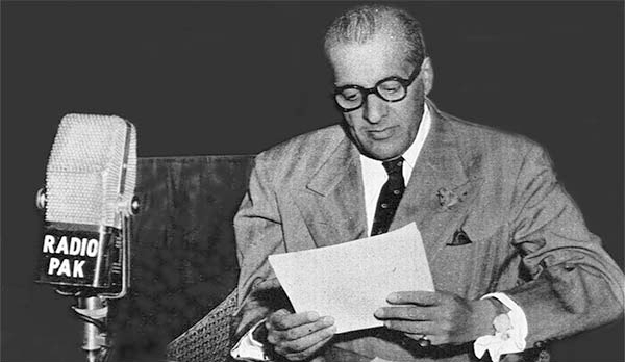 Governor-General Ghulam Mohammed. PHOTO: Pride of Pakistan
Governor-General Ghulam Mohammed. PHOTO: Pride of PakistanThe original purpose of this visit was for Governor-General Ghulam Muhammad to receive medical treatment in Boston.
However, he also travelled to Washington to meet President Dwight D Eisenhower and Secretary of Defense Charles Wilson, where discussions focused on military aid for Pakistan.
Prime Minister Mohammad Ali Bogra - October 14-21, 1954
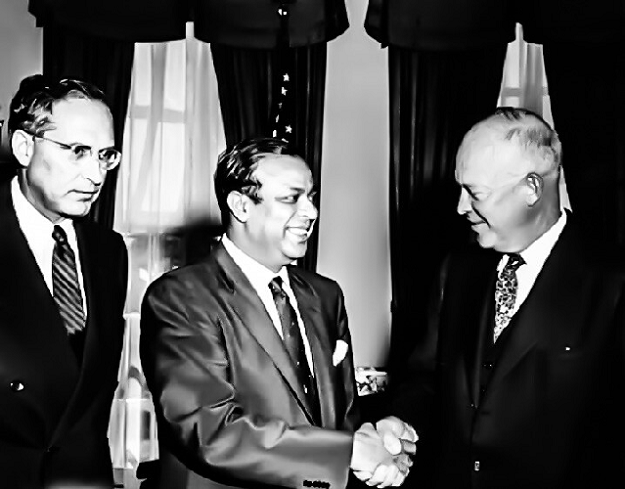 Prime Minister Muhammad Ali Bogra meeting President Eisenhower. PHOTO: flickr
Prime Minister Muhammad Ali Bogra meeting President Eisenhower. PHOTO: flickrMohammad Ali Bogra and some of his ministers visited the US and met President Dwight D Eisenhower and his secretary of state.
The cabinet members expressed satisfaction over the increasingly close relationship between the two countries.
The US president agreed to accelerate military programmes for Pakistan.
Prime Minister Huseyn Shaheed Suhrawardy - July 10-13, 1954
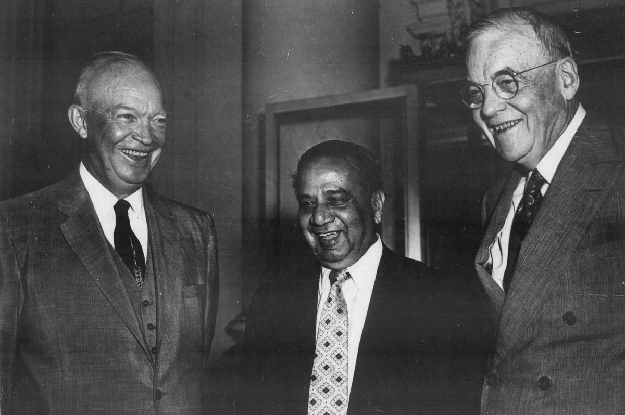 PM Suharwardy with President Eisenhower and Secretary of State Foster.
PM Suharwardy with President Eisenhower and Secretary of State Foster.Vice President Richard Nixon and Secretary of State John Foster received Prime Minister Suhrawardy in Washington. He was accompanied by his daughter on his three-day state visit.
He was escorted to the White House to meet President Eisenhower and held discussions on Pakistan's role in anti-communist pacts.
President Ayub Khan - July 11-14, 1961
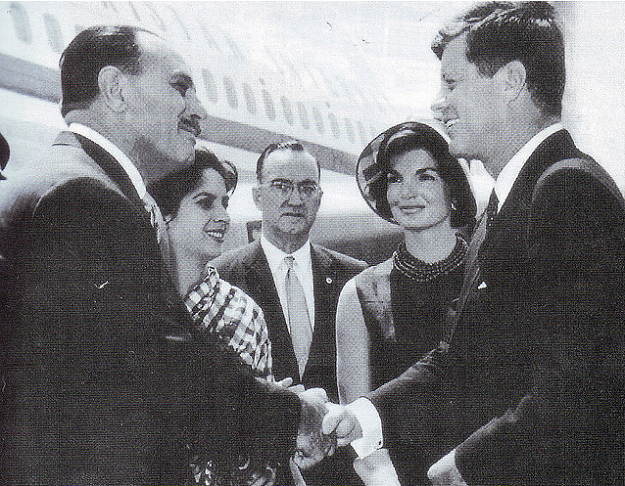 President JFK welcomed President Ayub Khan.
President JFK welcomed President Ayub Khan.Pakistan's first military dictator, President Ayub Khan, was received by US President John F Kennedy in Washington.
During his trip, he addressed the US Congress and expressed confidence that the friendship between the US and Pakistan would continue to grow stronger.
JFK welcomed Ayub Khan and called him the head of “an important and powerful country”.
President Ayub also held separate meetings with President JFK and Vice President Lyndon Johnson. They stressed the need for both countries to unite for the promotion of international peace and national security.
President Ayub Khan - September 24, 1962
President Ayub emphasised that the economic aid the US was providing to India was a threat to Pakistan’s security.
Kennedy said the US aid would help in negotiations with India on the Kashmir issue.
President Ayub Khan - December 14-16, 1965
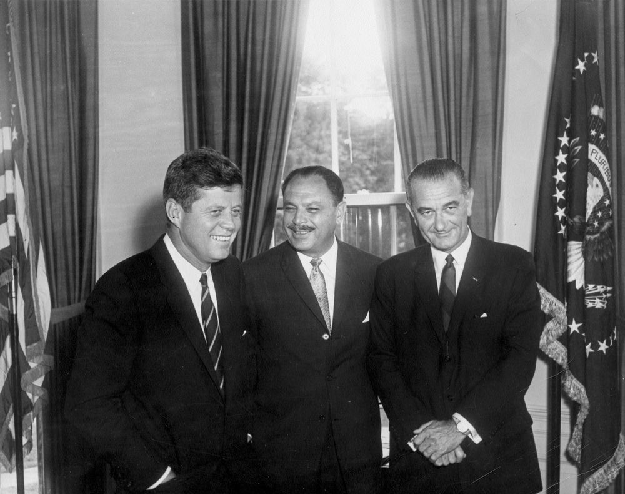 President Ayub meeting President Lyndon. PHOTO: White House photographs
President Ayub meeting President Lyndon. PHOTO: White House photographsPakistan’s relation with the US had reached the lowest point in 1965 when President Lyndon Johnson cancelled Ayub’s visit to Washington on September 6.
In December, Ayub visited President Johnson in the White House. He wanted the US to help with the Kashmir issue but the president told him that the alliance between the two countries was over and if Pakistan wanted military aid from the US in the future, it would need to avoid all ties with China.
President Agha Muhammad Yahya Khan - October 24-25, 1970
Military dictator President Agha Muhammad Yahya Khan visited the White House on the 25th anniversary of the UN to meet President Nixon and National Security Adviser Henry Kissinger.
A Top Secret Memorandum of Conversation stated: “Yahya is tough, direct and with a good sense of humour. He talks in a clipped way.”
Nixon informed Yahya that he was thinking of reestablishing contact with China and would like Yahya to act as an intermediary between Washington and Beijing.
Prime Minister Zulfikar Ali Bhutto - September 18-20, 1973
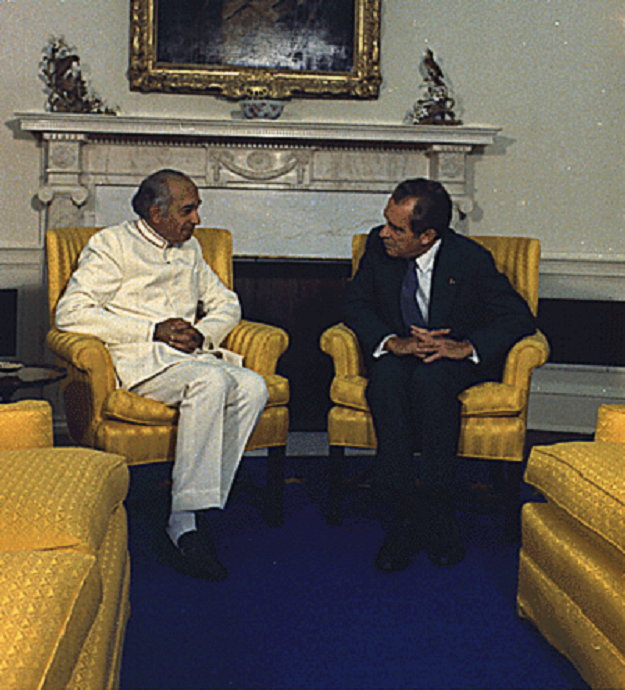 ZAB and President Nixon. PHOTO: Wikipedia
ZAB and President Nixon. PHOTO: WikipediaPrime Minister Zulfikar Ali Bhutto was welcomed by President Nixon at the White House.
The two leaders conferred privately in the president’s office where President Nixon told ZAB that the US was fully prepared to increase economic aid to Pakistan, but not military aid.
State officials informed ZAB that supply of lethal arms equipment from the US will remain closed to Pakistan.
Prime Minister Zulfikar Ali Bhutto - February 4-7, 1975
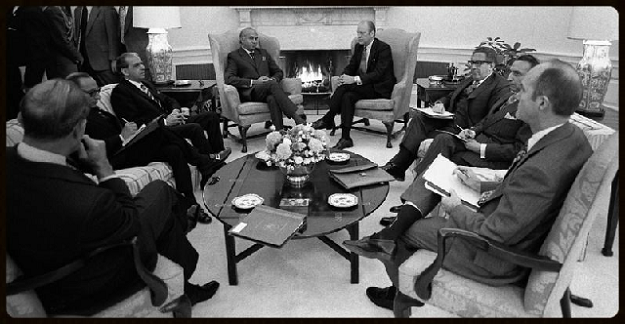 ZAB meets Gerald Ford. PHOTO: US Embassy Pakistan
ZAB meets Gerald Ford. PHOTO: US Embassy PakistanPrime Minister Zulfikar Ali Bhutto went on a state visit to meet President Gerald Ford and National Security Adviser Henry Kissinger in the Oval Office.
Before the dinner held in his honour, the leaders – accompanied by other ministers – spoke for an hour and 15 minutes, discussing relations with India, Congress’s position on arms sales to Turkey, and Kissinger’s Middle East negotiations.
President Muhammad Ziaul Haq - October 3, 1980
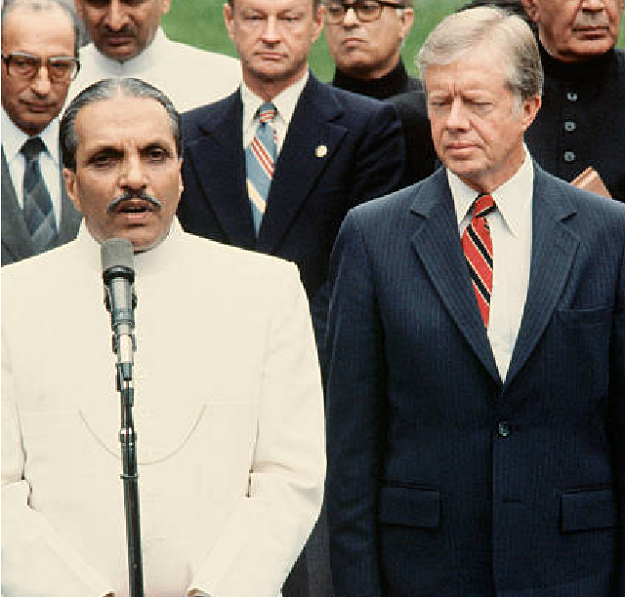 President Zia meets President Jimmy Carter. PHOTO: Online
President Zia meets President Jimmy Carter. PHOTO: OnlineMilitary dictator General Ziaul Haq met President Jimmy Carter on a private visit while attending the UN General Assembly session.
President Carter privately and publically expressed his admiration “for the courage of the people and the leaders of the great country of Pakistan”.
He spoke about the freedom and security of Pakistan and its importance to the US. He also reiterated his appreciation for “the friendship that exists between our two people”.
“If Pakistan should be in danger, the commitment [Mutual Defense Assistance Agreement] stands today as it did in 1959,” Carter said.
President Muhammad Ziaul Haq - December 6-9, 1982
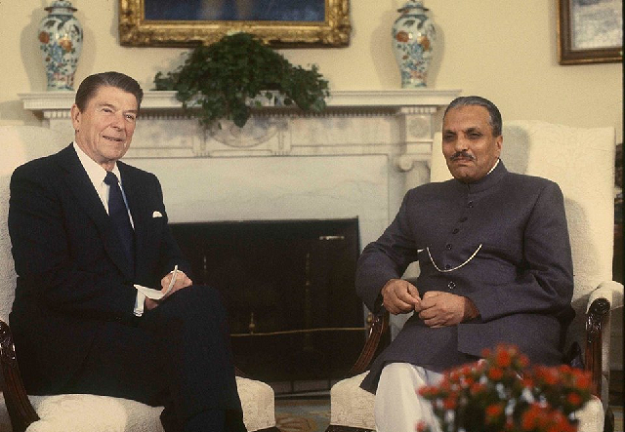 Zia ul Haq meeting Ronald Reagan. PHOTO: Online
Zia ul Haq meeting Ronald Reagan. PHOTO: OnlineZia arrived in Washington to meet President Ronald Reagan in the Oval Office at the White House.
He stated that he was pleased with his meeting with Reagan, in which he sought the continuation of a $3.2 billion US aid package to Pakistan.
The purpose of the aid package was to bolster Pakistan as a ‘front line state’ because of its proximity to the Persian Gulf, Soviet Union and Afghanistan, which Soviet troops invaded three years ago.
Referring to the meeting, Zia said: "It couldn’t have been better."
President Muhammad Ziaul Haq - October 23, 1985
Zia visited the US for the third time in 1985. During his one-day visit, Zia met President Reagan in New York City, followed by a luncheon at the UN.
Prime Minister Muhammad Khan Junejo - July 15-18, 1986
 PM Muhammad Khan Junejo with President Reagan.
PM Muhammad Khan Junejo with President Reagan.Prime Minister Muhammad Khan Junejo led a team of officials to the US.
After their conversation at the White House, Reagan described his conversation with Junejo as “upbeat, cordial and productive”.
High-level discussions were held on important issues, including Afghanistan and Pakistan’s role in ousting the Russians. President Reagan wanted assurance that Pakistan would not take any decisions that would hurt ties between the two countries.
The visit was successful with the US supporting Junejo’s government and emphasising the need for strong ties even after the anti-Russian operation.
Prime Minister Benazir Bhutto - June 5-7, 1989
 Benazir Bhutto meeting George W. Bush. PHOTO: UPI
Benazir Bhutto meeting George W. Bush. PHOTO: UPIPrime Minister Benazir Bhutto visited the US to meet President George H W Bush.
To date, she is the only Pakistani leader to address a joint session of the US Congress. Benazir also held meetings with key officials at the Pentagon, the State Department and the CIA.
Her agenda also included meetings with American business leaders and a speech at Harvard University.
During her 50-minute meeting with President Bush at the Oval Office, Benazir emphasised that a political settlement in Afghanistan was crucial for Pakistan so that Afghan refugees could return home.
Both leaders agreed that a military solution in Afghanistan could never be achieved.
President Farooq Leghari - May 23-27, 1994
 President Farooq Leghari.
President Farooq Leghari.President Farooq Leghari visited the US five years after Benazir Bhutto's last visit. He met President Bill Clinton during the private visit.
Prime Minister Benazir Bhutto - April 9-11, 1995
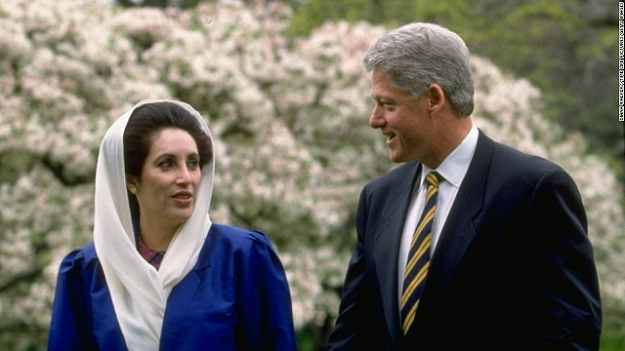 Benazir and Clinton. PHOTO: CNN
Benazir and Clinton. PHOTO: CNNBenazir was welcomed by President Bill Clinton in Washington.
During her visit, the premier and Clinton covered a range of subjects including Kashmir, Afghanistan, Central Asia and Gulf, Pakistan-India relations, nuclear proliferation, United Nations peacekeeping, and terrorism.
She called for an early resolution to the Kashmir issue and asked for a reassessment of the Pressler Amendment, which placed discriminatory sanctions on Pakistan.
Prime Minister Nawaz Sharif - September 22, 1997 - September 21, 1998 - December 1, 1998
Nawaz met with President Clinton at the UN General Assembly in New York City.
Prime Minister Nawaz Sharif - July 4-5, 1999
Prime Minister Nawaz met President Bill Clinton met for more than three hours and agreed that concrete steps will be taken to restore the line of control separating Pakistani and Indian forces in Kashmir.
President Pervez Musharraf - November 10, 2001
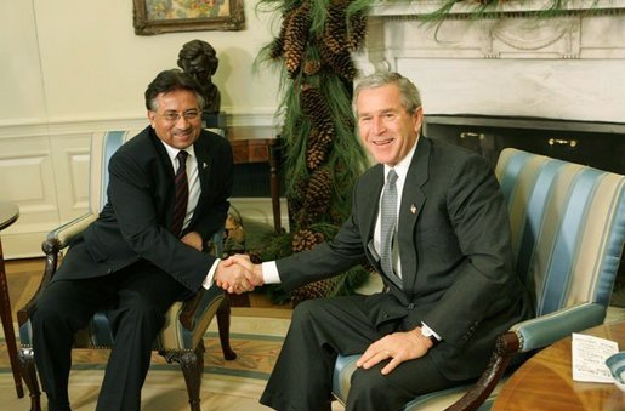 Musharraf with Bush in the Oval Office. PHOTO: US State Department
Musharraf with Bush in the Oval Office. PHOTO: US State DepartmentMilitary dictator Pervez Musharraf met George W Bush at the UN General Assembly in New York City.
The two discussed their alliance in the war against terrorism and Bush referred to Pakistan as “a front line [state]” in the War on Terrorism.
He lauded Pakistan’s efforts to combat terrorism and said they were benefiting the entire world and bringing Islamabad closer to other countries.
President Pervez Musharraf - February 12-14, 2002
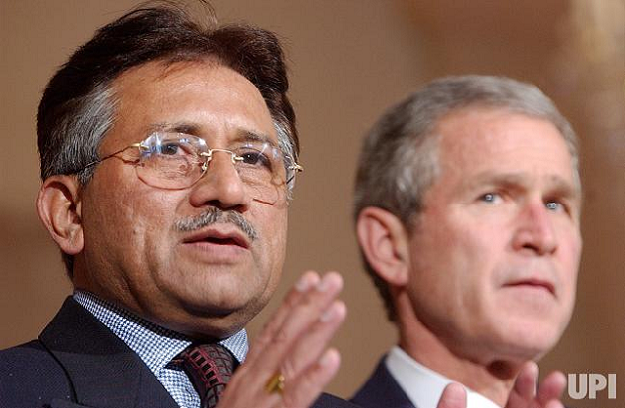 Musharraf and Bush. PHOTO: UPI
Musharraf and Bush. PHOTO: UPIGeneral Pervez Musharraf travelled to the US to meet George Bush in 2002 to press for more economic aid for Pakistan.
He was referred to as a leader of “great courage and vision” by Bush, who praised him for his assistance in the war against terrorism - similar to his visit the year before.
They discussed ways to build a stronger relationship in trade and investment and Bush vowed to “help improve education and economic opportunities for Pakistanis”.
They discussed the Kashmir issue and Bush vowed to help ease tensions between Pakistan and India.
President Pervez Musharraf - September 12, 2002
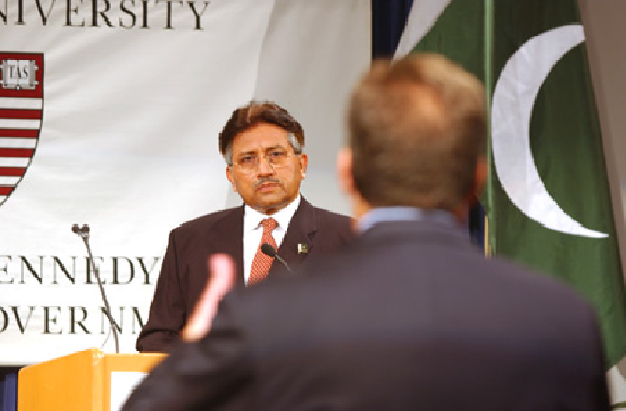 Musharraf speaking at Harvard University. PHOTO: The Harvard Gazette
Musharraf speaking at Harvard University. PHOTO: The Harvard GazetteDuring his visit to the US, Musharraf met the United Nations Secretary-General Kofi Annan as well as President George Bush.
He also spoke at Harvard University and underscored his support for the US military in rebuilding Afghanistan.
President Pervez Musharraf - June 23-27, 2003
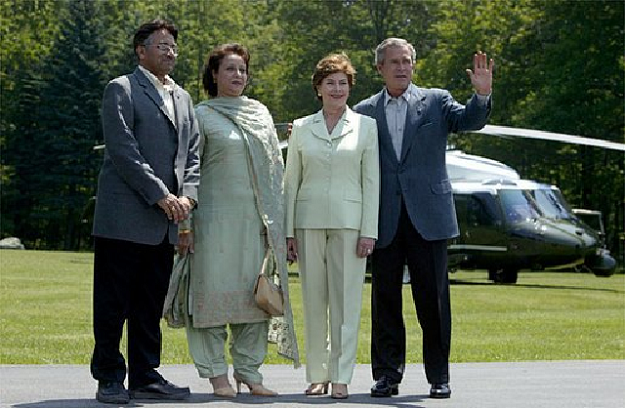 Musharraf at Camp David. PHOTO: The White House
Musharraf at Camp David. PHOTO: The White HouseGeneral Musharraf travelled to the US - accompanied by his wife Sehba - to meet President Bush at Camp David.
He was introduced as a “courageous leader and a friend of the United States,” by the US president.
During the moot, the two leaders discussed the need to address extremism and cross-border infiltration. Bush assured Musharraf that the US will do whatever is needed to promote peace.
The two leaders signed a trade and investment framework agreement to expand their economic partnership and Bush agreed to sign a $3 billion assistance package to increase economic opportunities for Pakistanis.
President Pervez Musharraf - September 24, 2003
Musharraf visited Bush again in September - three months after his previous visit - and the two reiterated the importance of friendship between both countries in order to strengthen their economic partnership.
Prime Minister Mir Zafarullah Khan Jamali - Sept 30-Oct 4, 2003
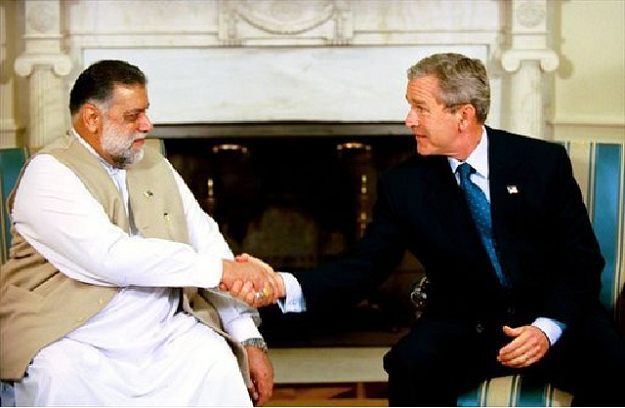 Zafarullah meeting Bush. PHOTO: Wikipedia
Zafarullah meeting Bush. PHOTO: WikipediaPrime Minister Mir Zafarullah Khan Jamali appeared to take up where Musharraf had left off just six days earlier.
During his visit, Jamali had lunch with Bush, met with Vice President Dick Cheney and the president of the World Bank, and also addressed a think tank.
The two leaders discussed bilateral, regional and international issues, as well as the close cooperation between the US and Pakistan in the war on terror.
President Pervez Musharraf - September 21-22, 2004
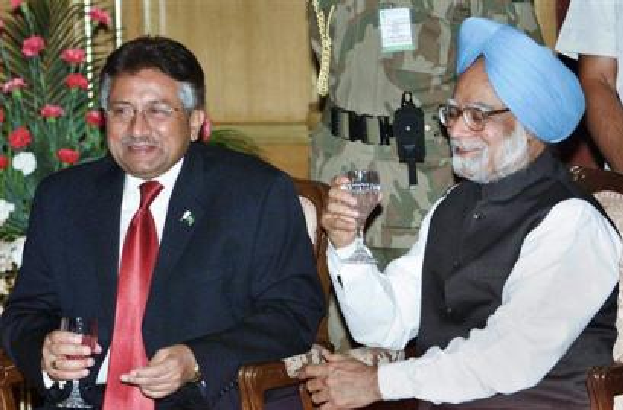 Musharraf with Indian PM Mahmohan Singh. PHOTO: China Daily
Musharraf with Indian PM Mahmohan Singh. PHOTO: China DailyMusharraf visited President George Bush in Washington - a year after his previous visit. He also met the Prime Minister of India Manmohan Singh during his two-day stay on the sidelines of the 59th UN General Assembly.
The two leaders discussed the Kashmir issue and Musharraf expressed concern that the progress on the issue was slow.
The Indian PM voiced concern over the existence of terrorist infrastructure in Pakistan, reminding Musharraf of his assurance not to allow territory under his country's control to be used for terrorist activities against India.
President Pervez Musharraf - December 3-4, 2004
 Musharraf and Bush. PHOTO: The White House
Musharraf and Bush. PHOTO: The White HousePrior to his visit to the United Kingdom, Musharraf stopped at the White House for a meeting with President Bush.
The two leaders discussed the need to work together against al-Qaeda.
Bush wanted assurances that Musharraf would continue to cooperate in this matter. Musharraf promised to look into it and wasn’t “aware that there was any problem”.
Prime Minister Shaukat Aziz - January 22-24, 2006
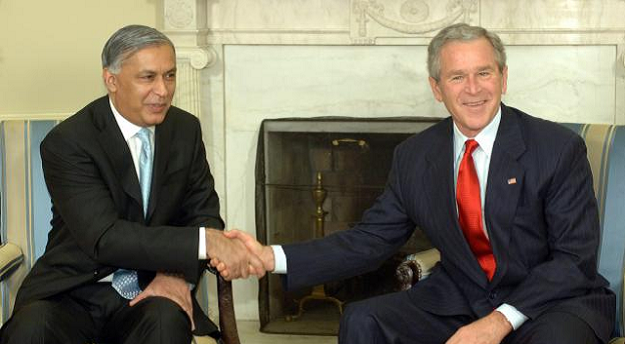 PM Shaukat Aziz with George Bush. PHOTO: UPI
PM Shaukat Aziz with George Bush. PHOTO: UPIThe prime minister’s visit came at a time when tensions were high between the two countries.
During the meeting, the two leaders discussed the US Damadola airstrike that had killed more than a dozen people, including women and children.
President Pervez Musharraf - September 20-22, 2006
Musharraf visited Bush again in 2006 and the two discussed the good work of the intelligence forces of both countries.
The two leaders discussed the earthquake rehabilitation process and Bush expressed his support for the people of Pakistan.
The two talked about economic development and a bilateral investment treaty, as well as education. Bush said, “I was impressed then, and I'm impressed now, by your commitment to an education system that prepares students for the - and gives students the skills necessary to compete in a global economy.”
They also discussed Pak-India relations, focusing on Kashmir, as well as the Afghanistan conflict.
Prime Minister Yousuf Raza Gilani - July 27-30, 2008
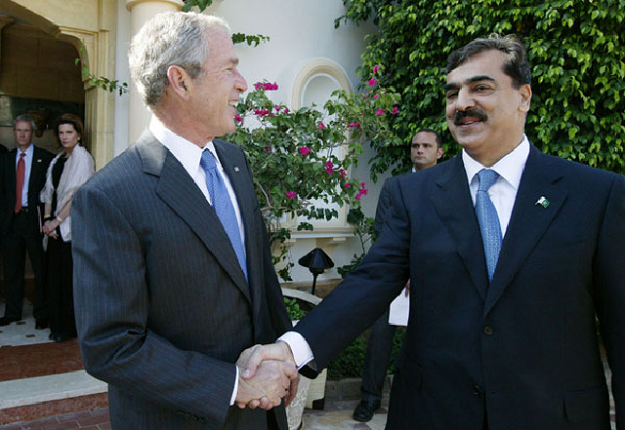
PHOTO: State Department
PM Yousuf Raza Gilani met President George Bush in the Oval Office, followed by lunch at the White House.
The two leaders discussed the benefits both countries could gain if they continued to work together.
Afghanistan was also a core focus of discussions and both leaders agreed to work to secure the Afghan border and ensure safety of the Afghan people.
President Asif Zardari - September 23, 2008
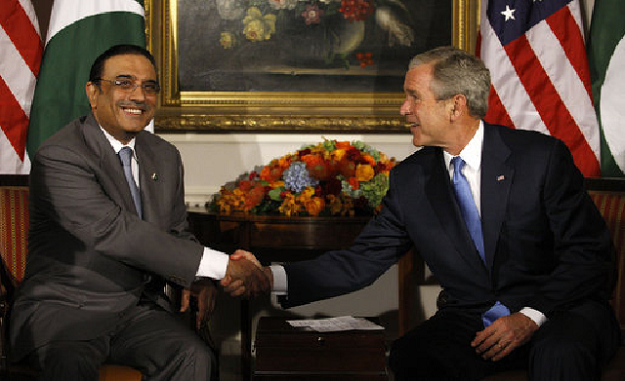 President Zardari with President Bush. PHOTO: The White House
President Zardari with President Bush. PHOTO: The White HousePresident Asif Zardari travelled to the US to meet President Bush, where Bush referred to Pakistan as “an ally” and expressed his concern over a terrorist attack in Islamabad.
He said he was looking forward to deepening the relationship between the two states and said he wanted both countries to work together to achieve economic prosperity.
The two leaders talked about regional security and Bush assured Zardari that the US wanted to help Pakistan.
President Asif Zardari - May 6, 2009
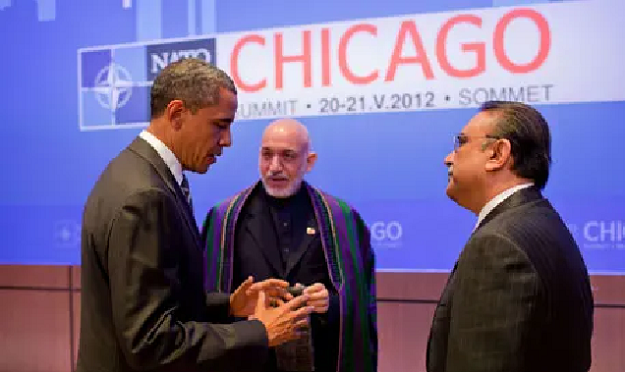
Zardari, Obama and Karzai. PHOTO: The Guardian
Zardari travelled to the US to meet President Obama and Afghan President Hamid Karzai to discuss the common goal of fighting terrorism and promoting stability in Afghanistan and the region.
The three leaders met to discuss ways to “disrupt, dismantle and defeat” al-Qaeda.
They talked about advancing security and opportunities for the people of Pakistan and Afghanistan.
President Asif Zardari - September 24-25, 2009
Zardari visited President Obama again in September for discussions on the war against terror and peace in Afghanistan.
Prime Minister Yousuf Raza Gilani - April 11-13, 2010
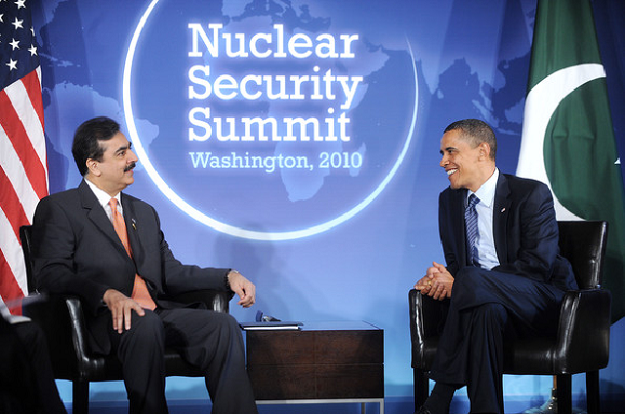 PM Gilani with President Obama.
PM Gilani with President Obama.PM Yusuf Raza Gilani attended the Nuclear Security Summit and also met President Obama.
Obama said he was “very fond of Pakistan” and pledged a long-term commitment to Pakistan.
The White House said the relationship between Pakistan and the United States was of significant importance because of the shared values and the fight both countries engaged in against extremists operating in South Asia.
Obama also noted that the multi-faceted and long-term strategic relationship between the two states went far beyond security issues.
President Asif Ali Zardari - January 14, 2011
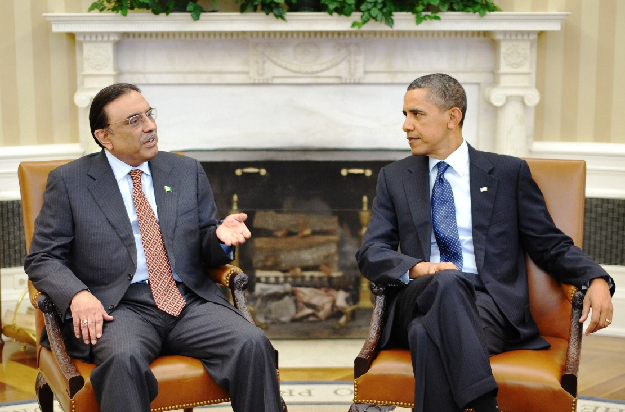 President Zardari and President Obama. PHOTO: AFP
President Zardari and President Obama. PHOTO: AFPZardari attended the Richard Holbrooke Memorial Service in the US where he met President Obama.
The two leaders voiced concerns over the rise in extremism around the world. The discussion focused on the shared efforts of both countries to fight terrorism and promote regional stability.
Obama also stated that he would visit Pakistan to help strengthen the bilateral relationship between both countries.
President Asif Ali Zardari - May 21, 2012
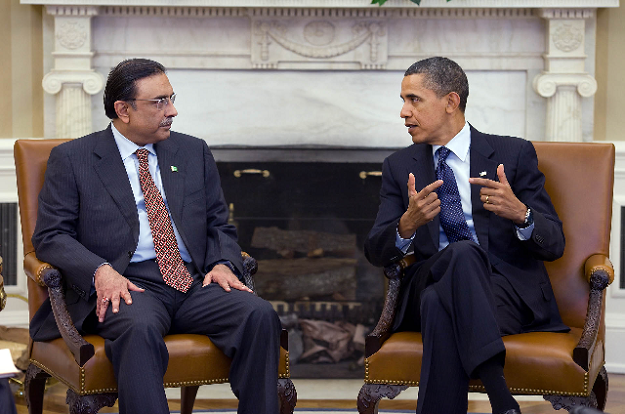
President Asif Zardari met President Obama briefly at the North Atlantic Treaty Organisation (NATO) Summit meeting in Chicago.
The US president declined to meet Zardari one-on-one because Pakistan refused to re-open the Afghan route to NATO – which meant the US and others had to resupply their military forces through the slower routes.
In his speech, Obama refused to acknowledge Pakistan, even though Zardari was present.
Prime Minister Nawaz Sharif - October 22-23, 2013
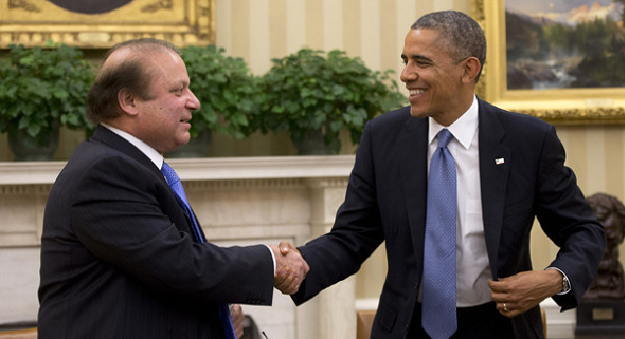 PHOTO: Reuters
PHOTO: ReutersFollowing the formal invitation extended to Nawaz by US Secretary of State John Kerry, Nawaz visited Washington to meet President Obama.
Nawaz wanted to have detailed talks with Obama on a range of issues from bilateral engagements to regional developments.
During the 33-minute discussion, the two sides reviewed the state of the bilateral relationship and agreed to expand and deepen cooperation.
The two leaders agreed that trade between the two states would contribute to the economic prosperity of Pakistan, which would benefit both the US and Pakistan.
Prime Minister Nawaz Sharif - October 22, 2015
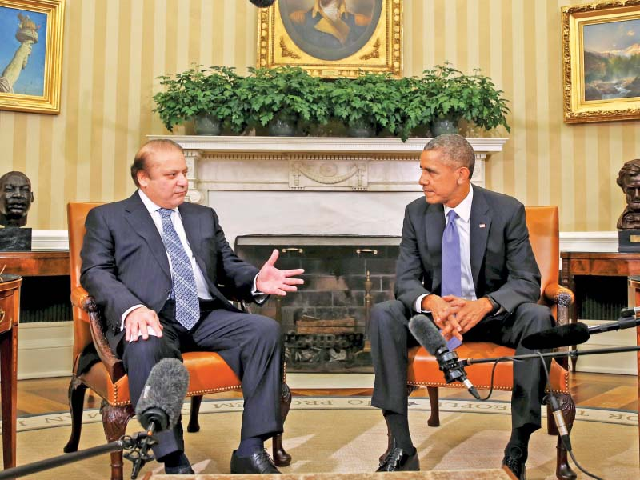 Prime Minister Nawaz Sharif with President Obama. PHOTO: Reuters
Prime Minister Nawaz Sharif with President Obama. PHOTO: ReutersAt the invitation of President Obama, PM Nawaz paid an official visit to Washington.
The leaders held wide-ranging discussions and reiterated the importance of friendship between the two regions in order to achieve regional and global peace and security.
They agreed that improving Pakistan-India bilateral relationships would improve the security and stability of the region.
They emphasised the importance of dialogue between the two states and aimed to resolve all disputes including the Kashmir issue.

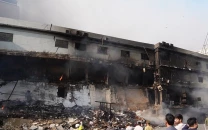
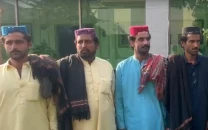
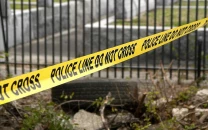
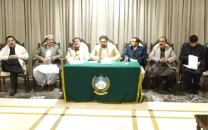














COMMENTS
Comments are moderated and generally will be posted if they are on-topic and not abusive.
For more information, please see our Comments FAQ